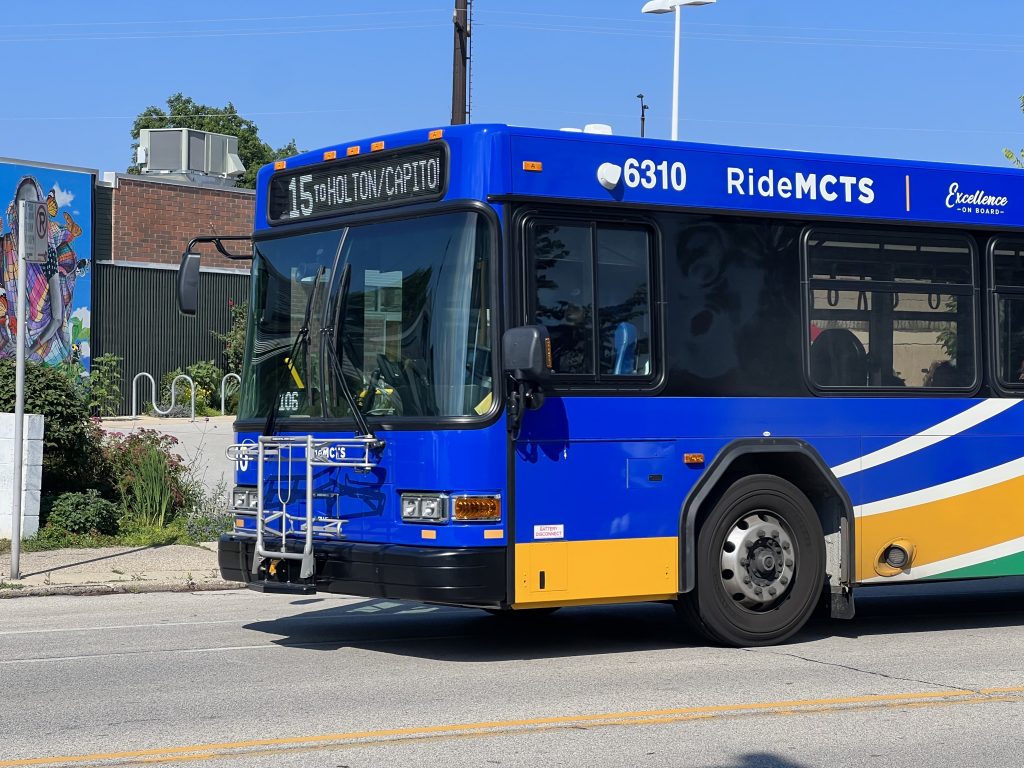MCTS Tries New Tactics To Improve Safety for Operators
Providing rides for bus operators back to the station after they end their shift.

MCTS bus. Photo by Jeramey Jannene.
The Milwaukee County Transit System (MCTS) is trying out new tactics for improving safety for drivers and riders.
The transit system is testing out two policies the bus operators’ union has long advocated for: using different security personnel and providing transportation between stations for operators.
MCTS recently announced its plan to supplement private security on the buses with new county-trained and staffed security personnel. Next year the system will also expand a transportation service for drivers running between their relief points and bus stations.
A relief point is a point along a bus route where an operator gets off their bus and is relieved by another driver who is starting their shift. For years, Amalgamated Transit Union Local (998) has advocated for some form of transportation between the relief point and the station. Drivers have been assaulted and harrassed while waiting for a bus to get back to their station.
Recently, MCTS worked with the union to pilot a transportation service, using MCTS-owned vans to pick up drivers at their relief points, as Kevin Pumphrey, MCTS Chief Operations Officer told the board’s Committee on Finance on Nov. 1.
“The program works fairly well,” Pumphrey said. “But there’s too many gaping holes in it.”
With only two vans MCTS isn’t able to give every bus operator a ride from their relief point.
The 2025 budget adopted by the county board Thursday includes two amendments aimed at expanding the relief transportation program. One is sponsored by Sup. Justin Bielinski, and it uses funding that was originally earmarked to purchase a new squad car for the Milwaukee County Sheriff‘s Office and instead uses it to purchase two vans for MCTS. The second was sponsored by Sup. Shawn Rolland and it provides MCTS approximately $35,000 to try using rideshare services like Uber and Lyft to provide relief pickup.
MCTS wasn’t interested in the first proposal, but was interested in the second one. Supervisors passed both, with Rolland saying that trying both ideas side by side will allows the transit system to figure out which works best.
Joe Lamers, director of the county’s Office of Performance, Strategy and Budget, reminded supervisors that while the pilot program for these services might only last a year, the vans they’re buying will last 10 to 15 years.
“If we decide Uber is a better program, now we have these vans, and I’m not sure what we’re doing with the vans after one year,” Lamers said.
MCTS officials are more interested in the rideshare program because they think it will allow them to provide rides for a wider group of operators, and because it will be cheaper than paying MCTS drivers to pick up their colleagues in vans. The overarching goal is to improve safety by having fewer operators waiting on the street for a bus to take them home.
“We want to be able to do it well,” Pumphrey said. “My personal opinion right now is: What we’re doing, we’re not doing it well there.”
Currently, the van service is kicking up fewer than 20% of operators. Doubling the number of vans would mean the system provides rides for 40% of operators at relief points, “on a good day,” Pumphrey added.
Bielinski argued against the rideshare proposal, criticizing Uber for its labor practices and the sexual assault and harassment allegations that have dogged the service. He also said he thought it was sending the wrong message to use unlicensed drivers from a private company to transport the county’s bus operators.
“I could probably get a lot of medical procedures for very cheap if I didn’t want to hire a licensed doctor,” Bielinski said. “I don’t think we want to be going for just the bottom bid every time”
If you think stories like this are important, become a member of Urban Milwaukee and help support real, independent journalism. Plus you get some cool added benefits.
MKE County
-
Fellow Judge Testifies in Dugan Case
 Dec 16th, 2025 by Graham Kilmer
Dec 16th, 2025 by Graham Kilmer
-
Key Questions in Dugan Trial Take Shape on First Day
 Dec 15th, 2025 by Graham Kilmer
Dec 15th, 2025 by Graham Kilmer
-
FTA Tells Milwaukee to Crack Down on Fare Evasion — Even Where Fares Don’t Exist
 Dec 12th, 2025 by Graham Kilmer
Dec 12th, 2025 by Graham Kilmer
Transportation
-
Congestion Pricing Cuts Air Pollution in New York City
 Dec 14th, 2025 by Jeff Wood
Dec 14th, 2025 by Jeff Wood
-
FTA Tells Milwaukee to Crack Down on Fare Evasion — Even Where Fares Don’t Exist
 Dec 12th, 2025 by Graham Kilmer
Dec 12th, 2025 by Graham Kilmer
-
Will GOGO’s Bus Service Ever Get Going?
 Dec 9th, 2025 by Jeramey Jannene
Dec 9th, 2025 by Jeramey Jannene





















There is something a bit odd about this story. Not to minimize the security incidents that have affected drivers, but the first question that comes to my mind is, what about the riders who also use those stops? Are they equally at risk of being assaulted, and if so, doesn’t the solution involve more than just a speedy transport option for drivers? Or is there something that puts the drivers at greater risk? Maybe I’m missing some key details here, so if Mr. Kilmer or a knowledgeable reader can add more detail, that’d be helpful.